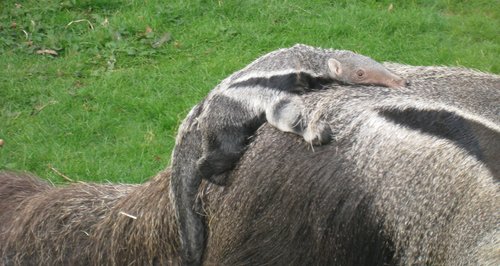Giant Anteater Pup Born At Cotswold Wildlife Park
7 April 2014, 14:12 | Updated: 7 April 2014, 14:33

The first pictures have been released of the only Giant Anteater baby to have ever been born at Cotswold Wildlife Park
The as yet unnamed pup is a result of the successful pairing of first-time parents Zorro and Zeta. They both arrived at the Burford collection in 2010. Zeta is proving to be a good mother, albeit a shy one. Anteaters are generally solitary creatures. Once a year, the female gives birth to a single pup. Gestation length is around 190 days. The mother carries her offspring on her back for approximately 6 months. One of their keepers managed to film a rare moment when the youngster briefly stood on its own four feet. The video can be seen on the Park’s YouTube channel here:
Curator of Cotswold Wildlife Park, Jamie Craig, commented: “It is always exciting for us to breed a species for the first time, and especially so in this case as the anteaters are such interesting creatures. The baby is a miniature version of the adults and is already exploring from the safety of its mother’s back, where it clings tenaciously with its already powerful claws.”
Giant Anteaters (Myrmecophaga tridactyla) are the largest of the four Anteater species and boast one of the most fascinat-ing tongues in the animal kingdom. They are edentate animals—they have no teeth. Their diet in the wild mainly consists of ants, termites and beetle larvae. The nests are ripped open with the claws and the tongue acts as animated fly-paper. These tongues can protrude more than 2 feet (60 cm) to capture prey. Ants possess a painful sting when attacked so Ant-eaters have to eat quickly. They do so by flicking their tongue up to 160 times per minute so to avoid being stung. An Anteater may spend only a minute feasting on each mound. They never destroy a nest, preferring to return and feed again in the future.
Giant Anteaters are classified as Vulnerable according to the IUCN* Red List of Threatened Species. Main threats to their survival are hunting and habitat destruction. Scientists estimate that there are only 5,000 individuals left in the wild.

